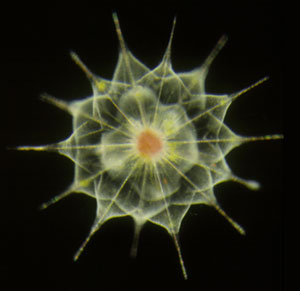 |

For further information, contact the MBL Communications Office at (508) 289-7423 or e-mail us at comm@mbl.edu
For Immediate Release: October 4, 2010
Contact: Gina Hebert, 508-289-7725; ghebert@mbl.edu
MBL Scientists Reveal Findings of World Ocean Microbe Census
Project Part of Historic Ten-Year Marine Life Census Culminating in London
 |
 |
The acantharians are one of the four types of large amoebae that occur in marine open waters. Their fragile skeletons are made of a single crystal of strontium sulfate that quickly dissolves in the ocean water after the cell dies. Photo Credit: Linda Amaral Zettler (micro*scope). Click for larger image.
Resources:
|
|
LONDON, UK—After a decade of joint work and scientific adventure, marine explorers from more than 80 countries, including six scientists from the Marine Biological Laboratory (MBL), today delivered the first global Census of Marine Life revealing what, where, and how much lives and hides in the world’s oceans. In one of the largest scientific collaborations ever conducted, more than 2,700 scientists spent over 9,000 days at sea on more than 540 expeditions gathering the data.
As a result of these efforts the scientists discovered that there may be up to 1 billion kinds of marine microbes—more than 100 times more diverse than plants and animals—and as many as 38,000 kinds of microbes in a typical liter of sea water.
A team of researchers from the MBL’s Bay Paul Center and their colleagues in 25 countries were among the scientists contributing to the Census through their leadership of the International Census of Marine Microbes (ICoMM), a research project of the larger Census of Marine Life, which focused on the biodiversity of microscopic life forms in the world's oceans.
Over the last six years, ICoMM has amassed more than 25 million genetic sequences from microbes that swim in 1,200 sites around the Earth—from polar bays to tropical seas; from estuaries to offshore; on corals, sponges, and whale carcasses; from surface waters to deep-sea
smokers.
Most of the Earth’s biodiversity is microbial in nature, particularly in the oceans. For more than three billion years, these creatures have mediated critical processes that shape the planet’s habitability.
In 2006, ICoMM scientists made the startling discovery that while a few microbial species dominate the oceans, most are very low in abundance. Mitchell Sogin, director of the MBL’s Bay Paul Center and ICoMM project leader called this new and unexplored realm of microbial life the “rare biosphere.”
Soon after this discovery, Sogin began utilizing a powerful type of DNA sequencer that enabled the analysis of microbial diversity in many more samples, much faster. His new method, called “Pyro-Tagging,” attracted additional funding to expand the census. A call to scientists got an enthusiastic and high-quality response, and 40 new labs were chosen to send marine microbial samples to the MBL for sequencing.
“From the very beginning, when we were deciding how we could do a survey of marine microbes, it has been a community effort,” says Sogin. “Sample collection is a very expensive game, mostly in terms of running ships, but the submitting labs paid for that, which relieved one financial hurdle for the census.” Meanwhile, at the MBL, “we realized right away that we needed bioinformatics capabilities that didn’t exist” to handle the data, Sogin says. So they designed databases that allow visualization of microbial diversity in several graphical ways and that combine genetic data with information on the microbes’ habitats.
Early on, ICoMM scientists also made the crucial decision to collect not just genetic data on the microbes (which would separate them by type), but also contextual information on where they were found—latitude and longitude, ocean depth, water pH, salinity, and other conditions. What they found is that all microbes are not everywhere. Despite an ability to disperse widely in the oceans, the scientists discovered that characteristic microbial communities can define different water masses in the ocean and can tell us about the health of different ecosystems.
“Believe it or not, this is unique, this coupling of (genetic) diversity data and contextual data,” says Linda Amaral Zettler, MBL assistant scientist and ICoMM program manager. “The big payoff is it lets the researchers ask ecological questions about microbial populations that otherwise could not be posed.”
Now is the most exciting time, when “things start to unfold, and stories are being told,” says Amaral Zettler. “We think our analyses will tell us very interesting stories.”
The Census of Marine Life was initiated in 2000 by the Alfred P. Sloan Foundation. During its decade the Census grew to a $650 million global exploration, involving over 670 institutions and more than 10 times the original 250 collaborators. The Census consisted of 17 projects that touch the major habitats and groups of species in the global ocean.
More than 300 leaders of the Census community met October 4 to 7 in London at the Royal Institution of Great Britain, the Royal Society, and Natural History Museum to share their decade of results and consider their implications.
A sequel to the Census will be explored during the London meetings and at the World Conference on Marine Biodiversity next September in Aberdeen, Scotland.
The MBL is a leading international, independent, nonprofit institution dedicated to discovery and to improving the human condition through creative research and education in the biological, biomedical and environmental sciences. Founded in 1888 as the Marine Biological Laboratory, the MBL is the oldest private marine laboratory in the Americas.
|